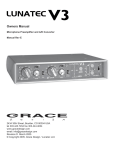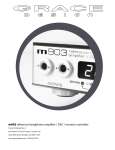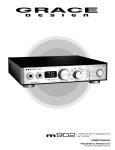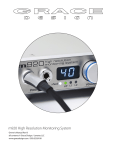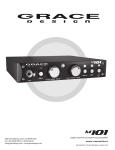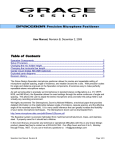Download Microplane LUNATEC V2 User's Manual
Transcript
OWNERS MANUAL LUNATEC V2 MICROPHONE PREAMPLIFIER PO Box 204 Boulder, CO. 80306 voice: 303.443.7454 fax: 303.444.4634 email: [email protected] Revision A December, 1998 © Copyright 1998, Lunatec LLC Thank you for purchasing the Lunatec V2 portable microphone preamplifier. It is designed and built to be extremely reliable and easy to use. This owner's manual includes important setup and operation instructions. Please take the time to familiarize yourself with these instructions which will help to avoid most common user problems. Grace Design has been building professional audio products for the recording industry for over ten years. During this time the circuit technology embedded in the Lunatec V2 has evolved through a process of extensive listening, testing and refinement. Regardless of what audio sources you plan to record, the Lunatec V2 will faithfully serve as an invisible link between your microphone and recorder device. We hope it helps you achieve a new level of excellence in your audio recordings. FEATURES OF THE LUNATEC V2 PREAMPLIFIER •Stereo preamplifier circuit •11 Position gain control •10-60dB gain range •10dB trim control •48Volt Phantom power for microphones •Signal and Peak LEDs •Two position High Pass Filter •Mid-Side recording matrix Figure 1. V2 Front Panel 2 FRONT PANEL CONTROLS GAIN CONTROL Each gain control has 11 positions and adjusts the voltage gain from 10dB to 60dB in 5dB steps. TRIM CONTROL The trim control provides 10dB of continuously variable output attenuation. In the fully clockwise position the trim is at unity (no attenuation). In the fully counter-clockwise position the trim is at -10dB. For reference, the 3 o’clock position is -4dB and the 12 o’clock position is -8dB. The trim control should be left in the fully clockwise position during normal recording. PHANTOM POWER This switch provides 48 volts to power condenser microphones. The phantom power switch (labeled +48) connects the +48V power supply to pins 2 and 3 on the XLR input connector. Alternatively, the V2 can be configured to provide 12V Parallel power. Please contact the factory for information on this option. PEAK INDICATOR The LED peak indicator, which monitors the signal between the input and output amplifiers, illuminates the green LED at -14dBu and illuminates the red LED at +16dB (10dB before clipping). HIGH PASS FILTER (labeled HPF) Sometimes referred to as a bass roll-off, the HPF uses a three position toggle switch to select two different low cut corner frequencies and an OFF position. Position 1 is the higher cutoff frequency and Position 2 is the lower cutoff frequency. Internal jumpers allow for selection of either 6dB/octave or 12dB/octave slope. The cutoff two frequencies can be set at 50Hz/100Hz or 75Hz/125Hz. Selecting HPF switch position 1 sets the roll-off to the higher frequency while switch position 2 sets the roll-off to the lower frequency. The 12dB/octave filter employs a transitional ThompsonButterworth response for the best combination of passband flatness and time domain response. See section II for detailed jumper setting information. POWER SWITCH The power switch connects power from the DC input connector to the preamplifier circuitry. If the preamplifier is connected to a charged battery or other DC power supply the POWER LED will illuminate. POWER LED Indicates that the V2 is turned on and connected to an adequate power source. NOTE: The 6 Volt V2 automatically turns off if the battery or power source voltage drops below 5.5V. The 12 Volt V2 automatically turns off if the battery or power source voltage drops below 11.0V. LOW BATT For the 6 Volt V2 the low battery indicator flashes if the battery voltage drops below 5.75V. For the 12 Volt V2 the low battery indicator flashes if the battery drops below 11.5V. 3 CONNECTING THE PREAMPLIFIER AUDIO CONNECTIONS Input connections are made using female XLR connectors. These are wired with pin 2 positive, pin 3 negative and pin 1 ground. 48V phantom power, if used, is supplied on pins 2 and 3. Output connections are made using male XLR connectors or RCA phono jacks. The XLR connectors are wired with pin 2 positive, pin 3 negative and pin 1 ground. Use the RCA phono jacks for unbalanced output. If the XLR outputs are to be used unbalanced, a modified cable is required and pin 3 should be left open. See figure 2 below. The XLR and the RCA outputs can be used simultaneously. 2 HOT GND 1 SHIELD 3 (OPEN) Figure 2. UNBALANCED OUTPUT CABLE TERMINATION POWER SUPPLY CONNECTIONS A four pin XLR connector is used for the DC power input of the V2. The V2 can be ordered to operate from either 6 or 12 Volt power sources. Pins 1 and 2 are ground and pins 3 and 4 are either 6 or 12V DC. To avoid compatibility problems it is recommended that 6 Volt systems be wired to use pin 3 for hot (+6v) and pin 2 for ground while 12 Volt systems should be wired to use pin 4 for hot (+12v) and pin 1 for ground. The V2 current draw ranges from .38A to .62A depending on the microphone used. 4 OPERATION SETTING THE GAIN Turn the gain control fully counter-clockwise, turn the trim control fully clockwise and check that the +48V phantom power is off. Connect the microphone to the preamplifier and then turn the phantom power switch on if required. When sending a signal to a tape recorder that has fixed input levels, simply increase the gain until the optimum recording level is reached. When sending a signal to a tape recorder with a variable input use the following procedure: Turn the gain control fully counter-clockwise, turn the trim control fully clockwise. Set the record level control on the recorder to 12 o’clock or midway between minimum and maximum. With the sound source present, turn the preamplifier gain control clockwise until the peak LED begins flashing red, then reduce the gain until the red stops flashing. Since red indicates a peak level which is 10dB before clipping, it is OK for it to come on occasionally during recording. Adjust the recorder input control for the optimum recording level. The trim control can be used for ultra fine output level adjustment as well as for level riding during recording. It should be noted that the maximum output level of the preamplifier is reduced by the amount of output attenuation being used. For instance, if the trim is set to 6dB the maximum output level of the preamplifier will drop from +26dBu to +20dBu. Since the LED peak indicator monitors signal level before the trim control it will always monitor the actual preamplifier headroom regardless of the trim control setting. It is best to leave the trim control fully clockwise for normal recording operations. This ensures that the preamplifier will be operated at the minimum necessary gain setting. USING THE V2 IN M-S MODE In MS mode the preamplifier accepts the Mid signal in channel 1 and the Side signal in channel 2. The channel 1 output (XLR or RCA) provides the “sum” of the inputs and the channel 2 output (XLR or RCA) provides the “difference” of the inputs. In the MS mode the CH 1 GAIN control adjust the amount of Mid signal in the “sum” and “difference” outputs. The CH 2 GAIN control adjusts the amount of SIDE signal in the “sum” and “difference” outputs. It is best to leave the TRIM controls at “0” and use the gain controls to adjust the stereo field. Equal gain on both channels will provide the widest stereo perspective while reducing the gain of the SIDE channel will decrease the width of the stereo field. 5 BATTERY CONSIDERATIONS With a standard pair of 48V condenser microphones the V2 draws roughly .48A. In our lab we have tested the V2 with an ECO-CHARGE Beta 6V 7.2A/h battery system. The V2 shuts down automatically after 13+ hours with a pair of Countryman Isomax II microphones. Note that this represents a complete discharge of a new and completely charged battery and if used in this fashion repeatedly the battery would degrade rapidly. 10 hours would be a conservative estimate.. A simple formula to determine useful battery life in hours is Hours= C ÷ .7 where C is the capacity of the battery in Amp-Hours. We have set the LOW BATTERY threshold so that the LED begins flashing after about 8 hours of run time (or about 5 hours before shutdown) to encourage the user to avoid deep discharges. However, no two batteries have the exact same discharge characteristics so the low battery threshold may represent different levels of reserve for different batteries. The V2 can be set at the factory to run at 6 or 12V. The current drain is the same at either voltage but the total power consumption will be twice as high for the 12V system. Also, it is normal for a 12Volt V2 to run warm to the touch. JUMPER SETTINGS In addition to the front panel controls, the Lunatec V2 has several options that can be selected with internal jumpers. Before making any changes to the internal jumpers always disconnect any power source from the V2, switch both +48 switches to the on position and wait for 1 minute before removing the top cover. This is to assure that all power has been discharged from the capacitors used in the power supply circuit. Refer to Figure 3 on page 6 for jumper locations for preamplifiers with serial number #V054 and below. Refer to figure 4 for preamplifiers with serial number #V055 and above. STEREO-MS MODE The V2 operates in a standard 2 channel stereo mode as well as MS or Mid-Side mode. Jumpers J7 and J17 select the mode. HIGH PASS FILTERS J5 and J6 select the filter slope for CH1. J18 and J19 select the filter slope for CH 2. J9 and J10 select the frequency range for CH 1. J15 and J20 select the frequency range for CH 2. HIGH PASS FILTER JUMPER SETTINGS J9,J10,J15,J20 HPF SWITCH POSITION CUTOFF FREQUENCY LOW HIGH 1 2 1 2 100Hz 50Hz 125Hz 75Hz Table 1. HPF Filter Frequency Selection 6 Figure 3. Circuit Board Jumper Locations SN #V054 and below Figure 4. Circuit Board Jumper Locations SN #V055 and above 7 SPECIFICATIONS EIN @60dB gain <130dB FREQUENCY RESPONSE +/- 3dB @60dB gain: 6Hz-250kHz THD+N +20dBu out @20dB gain +20dBu out @40dB gain +20dBu out @60dB gain 0.0011% 0.0011% 0.0046% INTERMODULATION DISTORTION @40dB gain +25dBu out <.0025% NOISE - REFERRED TO INPUT @60dB gain 50 Ohm source <-130dB PHASE DEVIATION 50-20Khz <8° CROSSTALK Either Channel -109dB CMRR @60dB gain, 3.5Vcm, 1KHz @60dB gain, 3.5Vcm, 10KHz Output CMRR 80dB 97dB 60dB MAXIMUM OUTPUT LEVEL Balanced Unbalanced +27dB +21dBu IMPEDANCE Input Output Minimum Load Impedance 1600Ohms 150Ohms 600Ohms WEIGHT 2.4lbs (1.1kg) DIMENSIONS L5.5” x W8.3” x H1.6” POWER CONSUMPTION 500mA DC 6-12V 8








